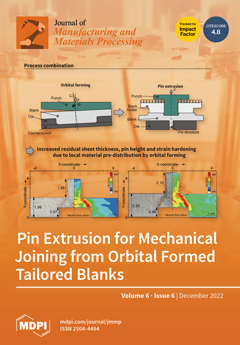Open AccessArticle
On the Lubricity and Comparative Life Cycle of Biobased Synthetic and Mineral Oil Emulsions in Machining Titanium Ti-6Al-4V at Low Cutting Speed
by
Paul Wood, Fathi Boud, Wayne Carter, Hirbod Varasteh, Urvashi Gunputh, Marzena Pawlik, Jenny Clementson, Yiling Lu, Syed Hossain, Matthew Broderick, Munusamy Raguraman, Andy Smith, Andy Mantle and Jamie McGourlay
Cited by 4 | Viewed by 1563
Abstract
The paper discusses an instrumented tapping test method using a CNC machine tool to compare the lubricity of MWFs by cutting threads in a Ti-6Al-4V alloy at low speed. The method uses a spiral flute tap size typical of industrial practice. A soft
[...] Read more.
The paper discusses an instrumented tapping test method using a CNC machine tool to compare the lubricity of MWFs by cutting threads in a Ti-6Al-4V alloy at low speed. The method uses a spiral flute tap size typical of industrial practice. A soft synchronous tap holder and spindle mounted dynamometer were incorporated on the machine to measure torque and thrust force. The tapping test method was demonstrated on three groups of MWFs that were commercially available and classified by ASTM E2523-13:2018. The method developed stable results free of chip clogging in tool flutes which could otherwise mask their comparative lubricity. The fully synthetic (FS) group displayed the best lubricity and within this group the FS from renewables (FS-bio) was the best overall. The method was shown to be effective in mitigating biasing effects on lubricity performance due to the generous tool chamfer angle tolerance and was practical and economical to implement. The significance of the results is discussed enabling an understanding of friction effects in tapping using a soft synchronous tap holder. A life cycle assessment of each MWF group found total Greenhouse Gas emitted from the FS group was 17% of the hydrocarbon group whilst FS-bio emitted just 7%.
Full article
►▼
Show Figures





